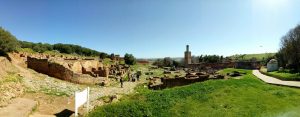Shallah, which is a hybrid name between Shelt and Sala, was the name of the city after the Roman authority has completely abandoned it. The Amazighs continued to live in the city as they did beforehand. These were the Amazighs that the Arab chroniclers would describe and whom the Arab governors would try to conquer in the 8th century when they arrived in this part of North Africa they named al-Maghreb al-Aqsa (literally the far West).
Al-Maghreb was one of the areas that were the hardest to conquer and the most hostile to maintain power over. The Amazigh tribes converted to Islam and back again to their original beliefs many times. Of the famous stories of resistance is that of an Amazigh Queen Dihya and her husband Koceila (Arabic deformation of the Amazigh name Akcil). Dihya was a skilled politician and fighter that died in battle for her people and their independence after the death of her husband.
After the Muslims gained control over some parts of the far West, they started mistreating the Amazighs, obliging them to pay taxes special to the non-Muslims (Jizya taxes) even though they converted to Islam. They ruled over them like they ruled over pagans and had very little regard towards them. Hence, the Amazighs remained in constant rebellion against the Umayyads and the Abbasids.
All this will change when the tribe of Awraba living in Volubilis (Walila) received a descendant of the prophet by the name of Idriss barely escaping the murder of him and his entire family by the Abbasids. It was the perfect solution for the Amazighs to the perpetual Arab presence. Here they had a true descendant of the prophet to teach them about the true religion and to grant them independence from the caliphate. Here began the Muslim history of al-Maghreb al-Aqsa with a dynasty central in importance to the people and to the Arab (Sharifian; descendants of the prophet) dynasties that came after it.
The Medieval buildings and ruins we have today in Shallah were constructed in the end of the 13th century and middle of the 14th century. This corresponds to the Merinid dynasty; an Amazigh dynasty that ruled over al-Maghreb al-Aqsa and much less than the Almoravids and Almohads on al-Andalus.
The site is famous for the Merinid royal necropolis and the complex of the Medersa.


